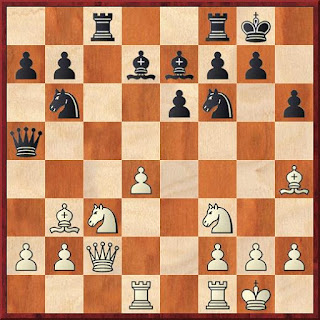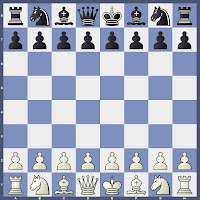Painless execution- Part 2: Lasker - Capablanca, Havana; 1921
"One can state, without exaggeration, that the observation of and the search for similarities and differences are the basis of all human knowledge" - Alfred Nobel
We pick from the position which is structurally similar to Matlakov - Kramnik but, here Lasker opted to have a different positioning for his Queen and the Queen's Rook, which was in vogue till recent past, but for some reason, losing attention.....probably the 'engines' and multicore processors may have given a..... "0.01".....but....
.....Capablanca himself was quoted saying..."7.Qc2 is considered inferior to Rc1. White was probably trying to deviate from the well-known paths."
But, don't we get a feeling that such considerations are more of the nature that; suppose we need to go to a particular destination, at times we feel it is better to take train....on another occasion we decide to go by bus....and who can guarantee that we reach the destination faster and safer by one method only!?
Every damn thing has its plusses and minuses....except the absolute suicide, of course! ....therefore....a choice is just a choice....a mere choice driven by the motions and emotions of a particular moment!
10.....cd4; 11.ed4 dc4; 12.Bc4 Nb6; 13.Bb3 Bd7; 14.OO Rac8
For some reason, in Moscow, 1935, Capablanca chose to play 14.....Bc6 instead of .....Rac8 against Stahlberg and landed in trouble!
What happened here.....in the future, that was rectified in the past!? Let us observe the game to find an answer. Stahlberg played....
15.Ne5 Bd5; 16.Nd5 Nbd5; 17.Qe2 Rad8; 18.f4! Ne8?; 19.Be7 Ne7; 20.f5! Nf5; 21.Nf7!!
Now, it is apparent! As it is a common knowledge, the side which opts for an IQP, should preserve his minor pieces and aim for utilising the squares secured by that isolated Q-pawn as a launch pad for some aggressive action on the Kingside.
In this position, precipitated by the mistake by Black on his 18th move, White got a decisive attack, with the help of his Knight posted on e5 and the Bishop sitting on b3! White used the standard technique of weakening this diagonal a2-g8 by the strategic pawn push f2-f4-f5.....
....lo....even the greatest of greatest can succumb to blindness....and allow White a free hand in carrying out the above! Capablanca should have prevented 20.f5 by playing 18.....g6 as the weakness that this move causes is a lesser evil to what transpired by its omission!
21....Rf7; 22.Qe6 Ned6;
....and in this position, instead of 22.g4? had Stahlberg played 22.Qe5! first, he would have romped home his advantage! After the mistake....the game ended in a draw...thus...
23.g4? Kh8! 24.Qe5 Qe5; 25.de5 Ne3; 26.Bf7 Nd1; 27.ed6 Rd6 Drawn
It is easy to miss that, at times the King can just walk away from the pin!
So, what is the great deal about playing either .....Rac8!? or .......Bc6?
The move .....Rc8 precludes the option of Nd5 and ensures that the transaction will happen on even terms: between the light squared Bishops of both sides.... after which, White is deprived of the free activity that he obtained on the a2-g8 diagonal!
The outcome of chess games hinges on such considerations....which the masters are truly aware....and yet....!
15.Ne5
Capablanca commented:
"Black has obtained an excellent development. He must now find the way either to exchange the White Bishop at h4 for his Bishop at e7, or to post a piece at d5 so as to bring about some exchanges that will simplify the position to some extent. All this must be done while keeping the White pawn at d4 immobile. White's weakness is his isolated QP. On the other hand the central position of the Black's pawn at e6 gives White more space and in consequence more freedom to manoeuvre "
.....and played.....
15......Bb5?
.....and said...."This weak move might have landed Black in a great deal of trouble...."
Instead he recommended 15.....Bc6 followed by 16.....Bd5....as he had already played ......Rac8!
16.Rfe1 Nbd5; 17.Bd5?
Capablanca condemned this move and suggested 17.Bf6! Bf6 (17.....Nf6?? 18.Ng6 Rfe8; 19.Re6! fe6; 20.Be6 Kh7; 21.Nf8 Kh8; 22.Qh7 Nh7; 23.Ng6#) 18.Bd5 ed5; 19.Qf5 Bc6; 20.Ng4 which maintains equilibrium!
17.....Nd5; 18.Be7 Ne7; 19.Qb3 Bc6!?
"The Bishop has to go back to this natural square....and this in itself is a condemnation of my 15th move....", commented Capablanca!
20.Nc6 bc6
Capablanca has managed to obtain what he envisaged in his comment after Lasker's 15th move (above).
21.Re5 Qb6; 22.Qc2 Rfd8; 23.Ne2
A very unfortunate necessity and generally it can be understood that if such moves had to be made by force, then that side can be said to be on the defensive.....
23......Rd5! 24.Rd5 cd5;
Capablanca commented in his typical way, thus...
"Black has consolidated his position. He holds the open file, his pieces are very well placed, and the only weak point - his isolated a-pawn - cannot be attacked because of the general situation of the pieces. The question is, how can Black benefit from all this?
From now on the student will do well to study carefully every move up to the end. It is one of Black's best efforts in his whole career, and that against one of the strongest players the world has ever seen."
In fact, as Botvinnik said, "It is impossible to understand the world of chess without looking at it with the eyes of Capablanca"!
And now commences our journey, in spirit, with what we saw in the game played by Kramnik in the previous post.
25.Qd2 Nf5; 26.b3 h5?! 27.h3?! h4!
These are typical stratagems of Masterclass! Keeping one's pawn's (where one has majority, in particular) mobile and immobilising opponent's pawns and fixing them, are paramount on most occasions and in the endgames in particular.
28.Qd3 Rc6; 29.Kf1 g6; 30.Qb1 Qb4; 31.Kg1 a5! 32.Qb2 a4
"By the advance on the Q-side, Black not only removes his only weakness, the isolated a-pawn, but he creates a new weakness in White's game, since White will soon have another isolated pawn besides his Queen pawn." - Capablanca
33.Qd2 Qd2; 34.Rd2 ab3; 35.ab3 Rb6; 36.Rd3 Ra6
Shall we take a stock of the position!?
- White has three pawn islands and Black has one compact unit
- White's Rook is passively defending both his isolated pawns and is severely handicapped, whilst Black's Rook is highly mobile and has visa to travel wherever he wants!
- Thought White's Knight is somewhat ok, he is still not equal to Black's Knight standing majestically on f5 outpost - attacking one isolated pawn and has freedom to hop around if needed!
37.g4 hg3; 38.fg3 Ra2; 39.Nc3 Rc2! 40.Nd1 Ne7; 41.Nc3 Rc1; 42.Kf2 Nc6!
Now one of the isolated pawn falls!
43.Nd1 Rb1; 44.Ke2?
But, 44.Ke1 does not solve his problems either...44.Ke1 Na5; 45.Kd2 Rb3 etc.
44.....Rb3! 45.Ke3 Rb4!
"Having his choice, Black prefers this ending to the more simple King and Knight ending!" - Capablanca
46.Nc3 Ne7! 47.Ne2 Nf5; 48.Kf2 g5; 49.g4 Nd6; 50.Ng1 Ne4; 51.Kf1 Rb1; 52.Kg2 Rb2; 53.Kf1 Rf2; 54.Ke1 Ra2
"All these moves with the Rook have been to obtain this particular position." - Capablanca
Now Black King starts marching towards the center to clinch the issue!
55.Kf1 Kg7; 56.Re3 Kg6; 57.Rd3 f6; 58.Re3 Kf7; 59.Rd3 Ke7; 60.Re3 Kd6; 61.Rd3 Rf2; 62.Ke1 Rg2; 63.Kf1 Ra2; 64.Re3 e5; 65.Rd3 ed4; 66.Rd4 Kc5; 67.Rd1 d4; 68.Rc1 Kd5 and Lasker Resigned
Rabindranath Tagore said...
"Stillness soars as a mountain peak,
Seeking its greatness in height.
Movement stops in a silent lake,
Seeking in depth its limit."
Seeking its greatness in height.
Movement stops in a silent lake,
Seeking in depth its limit."








.jpg)
.jpg)

Comments
Post a Comment